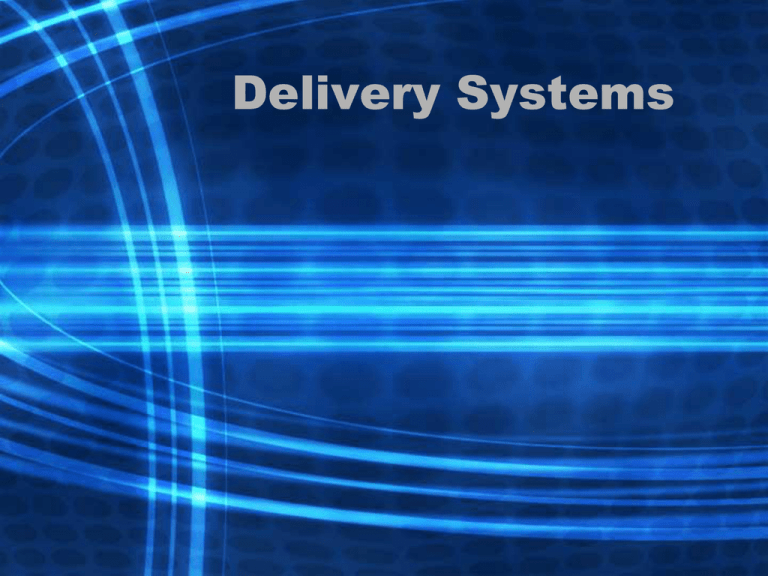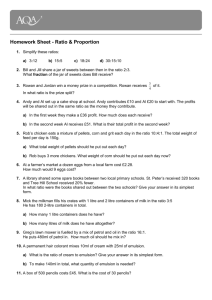Delivery Systems Powerpoint 2
advertisement

Delivery Systems Overview • Why transport is important? • Types of delivery system • Factors to be considered when choosing a delivery system • Modern developments in delivery systems • Calculating delivery costs Why is transport important? • • • • A good transport system is important to business: To deliver raw materials to the manufacturer To deliver finished goods to retailers To transport workers to their jobs To transport goods abroad Types of delivery systems • • • • • • Road Rail Sea Air Pipeline Canal Road Advantages • Fast over short distances • Door-to-door deliveries (entire country is accessible) • Minimum handling • Flexible, convenient and cheap – operates 24 hours a day Disadvantages • Congestion/poor roads – delays • Bad weather – delays • Not suitable for bulky goods • Slow over long distances • Cost of drivers, tax and insurance is high Rail Advantages • Fast over long distances • Suitable for bulky goods • Reliable • Cheap for bulky goods • Can carry containers and chemicals • Not affected by weather and traffic congestion • Railways service the main ports – important for firms that export Disadvantages • Not flexible – fixed timetable • Lot of handling – other methods of transport to and from the station are needed • Fixed routes • Expensive over short distances • Not every city/town is served by a railway station Lack of integrated rail network throughout the country Sea Advantages • Suitable for bulky goods • Large cargos can be carried • Cheaper than air • Suitable for containers • Good facilities at ports • Modern ships – large loads Disadvantages • Slow over long distances • Weather conditions – delays • Not flexible – fixed timetable • Must link with other forms of transport • High insurance costs Types of ship • Cargo ships (LO-LO) • Ferries (RO-RO) • Tramp ships Container ships Air Advantages: • Fast • Suitable for perishable goods and goods needed urgently • Good safety record • Less packing – reduced cost • Modern aircraft – large loads • Less likelihood of damage/theft • Good network of regional airports Disadvantages • Expensive • Bad weather – delays • Must link with other forms of transport • Not flexible – fixed timetable • Not suitable for bulky goods Pipeline Advantages: • Safe • Cheap to maintain Disadvantages: • Expensive to install • Suitable only for liquids or gases Canal • Man-made waterway • Not commonly used in Ireland, except as a tourist attraction • Used extensively in Europe • Famous canals: Amsterdam, Venice, Suez, Panama • Ship canals may be used to link major cities with sea ports, e.g. Manchester linked with Liverpool Suez Canal Joins the Red Sea and Mediterranean Sea in Egypt Panama Canal • Connects the Caribbean Sea to the Pacific Ocean • 50 miles long Factors affecting choice of delivery system • Cost – Delivery adds to the selling price of goods • Reliability – The system should be punctual. A delay in delivery could cause a delay in production for “just-in-time” • Convenience – Delivery should be available when required • Speed/Type of goods – Very important for perishable goods (e.g. fresh fish) and urgently needed supplies (e.g. medicine) • Distance – The distance between the buyer and seller can mean a number of transport methods must be used Modern Developments in Transport • • • • • • Containers Refrigeration Tachograph Euro Tunnel Toll roads/toll bridges Quality Bus Corridors (QBC) Containers • Large metal boxes of standard size • Minimum handling of goods required once sealed in the container • Small firms may share a container to reduce costs Refrigeration Refrigerated containers are used for transporting perishable goods, e.g. meat, fish, etc. Tachograph An instrument installed in the cab of a truck/lorry that measures the hours (and speed) driven as well as the breaks taken by the driver Euro-Tunnel • The Euro-Tunnel linking Folkestowe in England with Calais in France was opened in 1993 • This provides a regular, fast rail link between the UK and mainland Europe Quality Bus Corridors • Special lanes that buses can use to provide a quicker and more effective service • Public transport becomes more attractive because it will be quicker and more punctual Toll roads/Toll bridges • Built by private firms who charge a fee for their use RO-RO & LO-LO Calculation of Delivery Cost Brady Ltd., a fruit and vegetable wholesaler which operates 325 days a year supplies the following information: • Distance travelled each • Employer’s PRSI is 12.5% of day is 740km gross pay • The diesel van can • Annual motor tax is €1,300 travel 34km per litre • Annual motor insurance is • The cost per litre of €2,275 diesel is €1.05 • Annual motor repairs are • Mark Hennessy, the €1,300 driver is paid €200 per • Toll charges are €20 per day day Calculate the total cost of transport for one day Solution € FIXED COSTS € Annual motor tax 1,300 Annnual motor insurance 2,275 Annual motor repairs 1,300 Total fixed costs 4,875 Daily fixed costs 4,875/325 15 FUEL COSTS Distance travelled per day 740 Divide by kilometres per litre 37 Daily fuel used 20 Cost per litre 20 x 1.05 21 OTHER VARIABLE COSTS Driver's wages 200 Employer's PRSI (USC) 25 Toll charges 20 TOTAL COST FOR ONE DAY 245 281 Review and Recap • Why transport is important? • What are the different common types of delivery system? • What factors need to be considered when choosing a delivery system? • List and explain four modern developments in delivery systems • Explain how a business calculates delivery costs





